Healthcare Leadership Development Programs
VerifiedAdded on 2020/05/08
|11
|3621
|256
AI Summary
This assignment examines the crucial role of leadership development programs in the healthcare sector. It investigates the effectiveness of these programs, analyzes the challenges faced in implementing them, and explores best practices for successful leadership development within healthcare organizations.
Contribute Materials
Your contribution can guide someone’s learning journey. Share your
documents today.

TOPIC: EFFECTIVE LEADERSHIP IN HEALTH
NAME
STUDENT ID
SUBJECT
DATE
1
NAME
STUDENT ID
SUBJECT
DATE
1
Secure Best Marks with AI Grader
Need help grading? Try our AI Grader for instant feedback on your assignments.
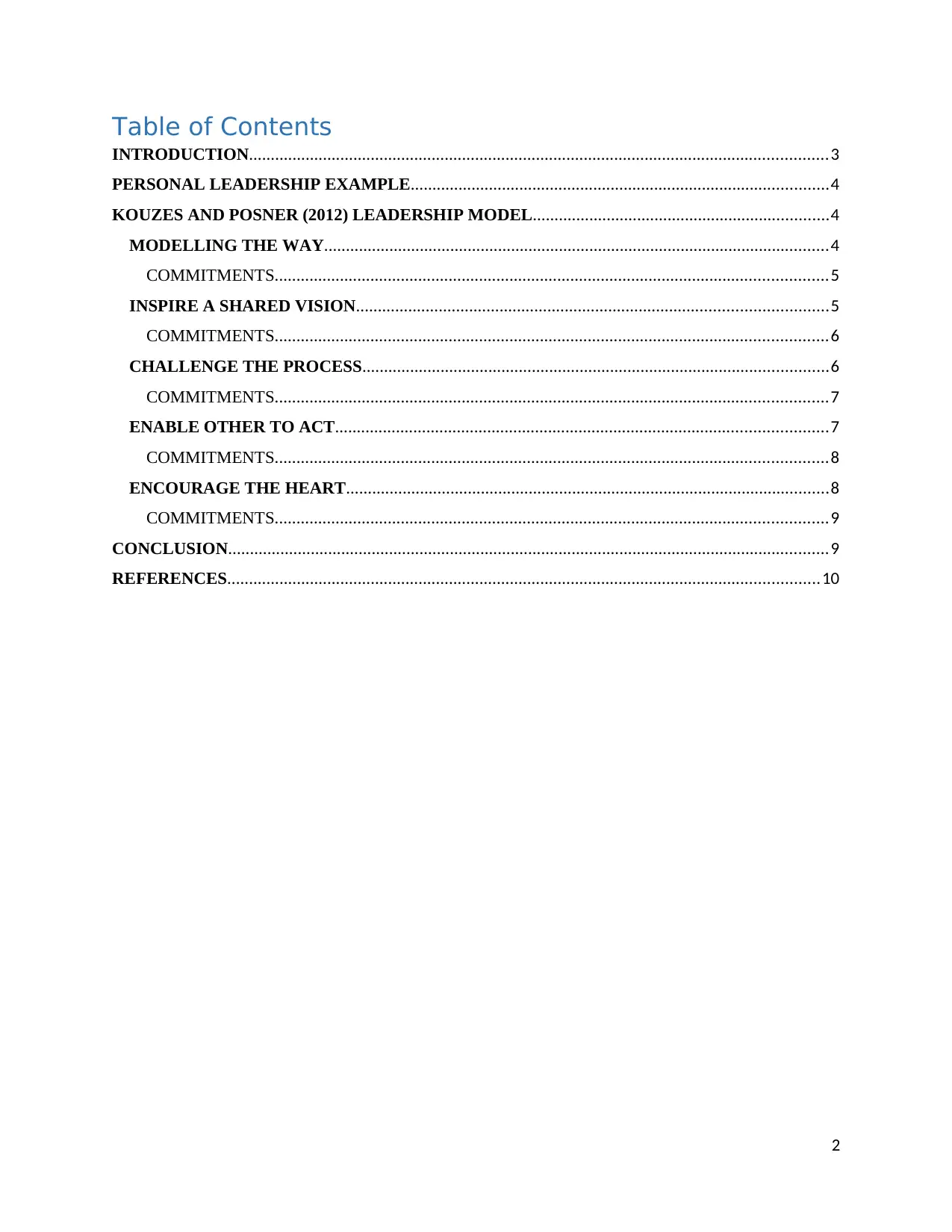
Table of Contents
INTRODUCTION.....................................................................................................................................3
PERSONAL LEADERSHIP EXAMPLE................................................................................................4
KOUZES AND POSNER (2012) LEADERSHIP MODEL....................................................................4
MODELLING THE WAY....................................................................................................................4
COMMITMENTS...............................................................................................................................5
INSPIRE A SHARED VISION............................................................................................................5
COMMITMENTS...............................................................................................................................6
CHALLENGE THE PROCESS...........................................................................................................6
COMMITMENTS...............................................................................................................................7
ENABLE OTHER TO ACT.................................................................................................................7
COMMITMENTS...............................................................................................................................8
ENCOURAGE THE HEART...............................................................................................................8
COMMITMENTS...............................................................................................................................9
CONCLUSION..........................................................................................................................................9
REFERENCES........................................................................................................................................10
2
INTRODUCTION.....................................................................................................................................3
PERSONAL LEADERSHIP EXAMPLE................................................................................................4
KOUZES AND POSNER (2012) LEADERSHIP MODEL....................................................................4
MODELLING THE WAY....................................................................................................................4
COMMITMENTS...............................................................................................................................5
INSPIRE A SHARED VISION............................................................................................................5
COMMITMENTS...............................................................................................................................6
CHALLENGE THE PROCESS...........................................................................................................6
COMMITMENTS...............................................................................................................................7
ENABLE OTHER TO ACT.................................................................................................................7
COMMITMENTS...............................................................................................................................8
ENCOURAGE THE HEART...............................................................................................................8
COMMITMENTS...............................................................................................................................9
CONCLUSION..........................................................................................................................................9
REFERENCES........................................................................................................................................10
2
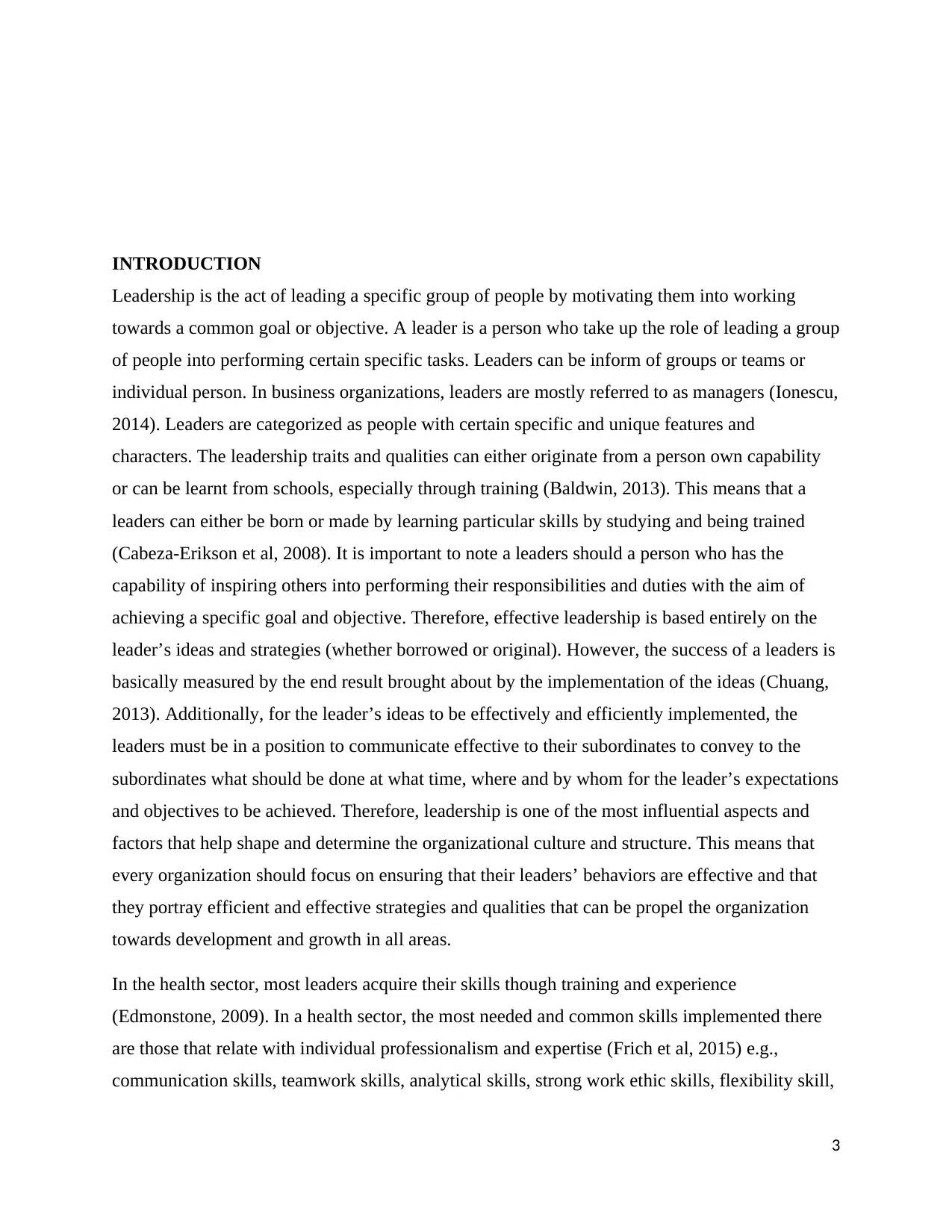
INTRODUCTION
Leadership is the act of leading a specific group of people by motivating them into working
towards a common goal or objective. A leader is a person who take up the role of leading a group
of people into performing certain specific tasks. Leaders can be inform of groups or teams or
individual person. In business organizations, leaders are mostly referred to as managers (Ionescu,
2014). Leaders are categorized as people with certain specific and unique features and
characters. The leadership traits and qualities can either originate from a person own capability
or can be learnt from schools, especially through training (Baldwin, 2013). This means that a
leaders can either be born or made by learning particular skills by studying and being trained
(Cabeza-Erikson et al, 2008). It is important to note a leaders should a person who has the
capability of inspiring others into performing their responsibilities and duties with the aim of
achieving a specific goal and objective. Therefore, effective leadership is based entirely on the
leader’s ideas and strategies (whether borrowed or original). However, the success of a leaders is
basically measured by the end result brought about by the implementation of the ideas (Chuang,
2013). Additionally, for the leader’s ideas to be effectively and efficiently implemented, the
leaders must be in a position to communicate effective to their subordinates to convey to the
subordinates what should be done at what time, where and by whom for the leader’s expectations
and objectives to be achieved. Therefore, leadership is one of the most influential aspects and
factors that help shape and determine the organizational culture and structure. This means that
every organization should focus on ensuring that their leaders’ behaviors are effective and that
they portray efficient and effective strategies and qualities that can be propel the organization
towards development and growth in all areas.
In the health sector, most leaders acquire their skills though training and experience
(Edmonstone, 2009). In a health sector, the most needed and common skills implemented there
are those that relate with individual professionalism and expertise (Frich et al, 2015) e.g.,
communication skills, teamwork skills, analytical skills, strong work ethic skills, flexibility skill,
3
Leadership is the act of leading a specific group of people by motivating them into working
towards a common goal or objective. A leader is a person who take up the role of leading a group
of people into performing certain specific tasks. Leaders can be inform of groups or teams or
individual person. In business organizations, leaders are mostly referred to as managers (Ionescu,
2014). Leaders are categorized as people with certain specific and unique features and
characters. The leadership traits and qualities can either originate from a person own capability
or can be learnt from schools, especially through training (Baldwin, 2013). This means that a
leaders can either be born or made by learning particular skills by studying and being trained
(Cabeza-Erikson et al, 2008). It is important to note a leaders should a person who has the
capability of inspiring others into performing their responsibilities and duties with the aim of
achieving a specific goal and objective. Therefore, effective leadership is based entirely on the
leader’s ideas and strategies (whether borrowed or original). However, the success of a leaders is
basically measured by the end result brought about by the implementation of the ideas (Chuang,
2013). Additionally, for the leader’s ideas to be effectively and efficiently implemented, the
leaders must be in a position to communicate effective to their subordinates to convey to the
subordinates what should be done at what time, where and by whom for the leader’s expectations
and objectives to be achieved. Therefore, leadership is one of the most influential aspects and
factors that help shape and determine the organizational culture and structure. This means that
every organization should focus on ensuring that their leaders’ behaviors are effective and that
they portray efficient and effective strategies and qualities that can be propel the organization
towards development and growth in all areas.
In the health sector, most leaders acquire their skills though training and experience
(Edmonstone, 2009). In a health sector, the most needed and common skills implemented there
are those that relate with individual professionalism and expertise (Frich et al, 2015) e.g.,
communication skills, teamwork skills, analytical skills, strong work ethic skills, flexibility skill,
3
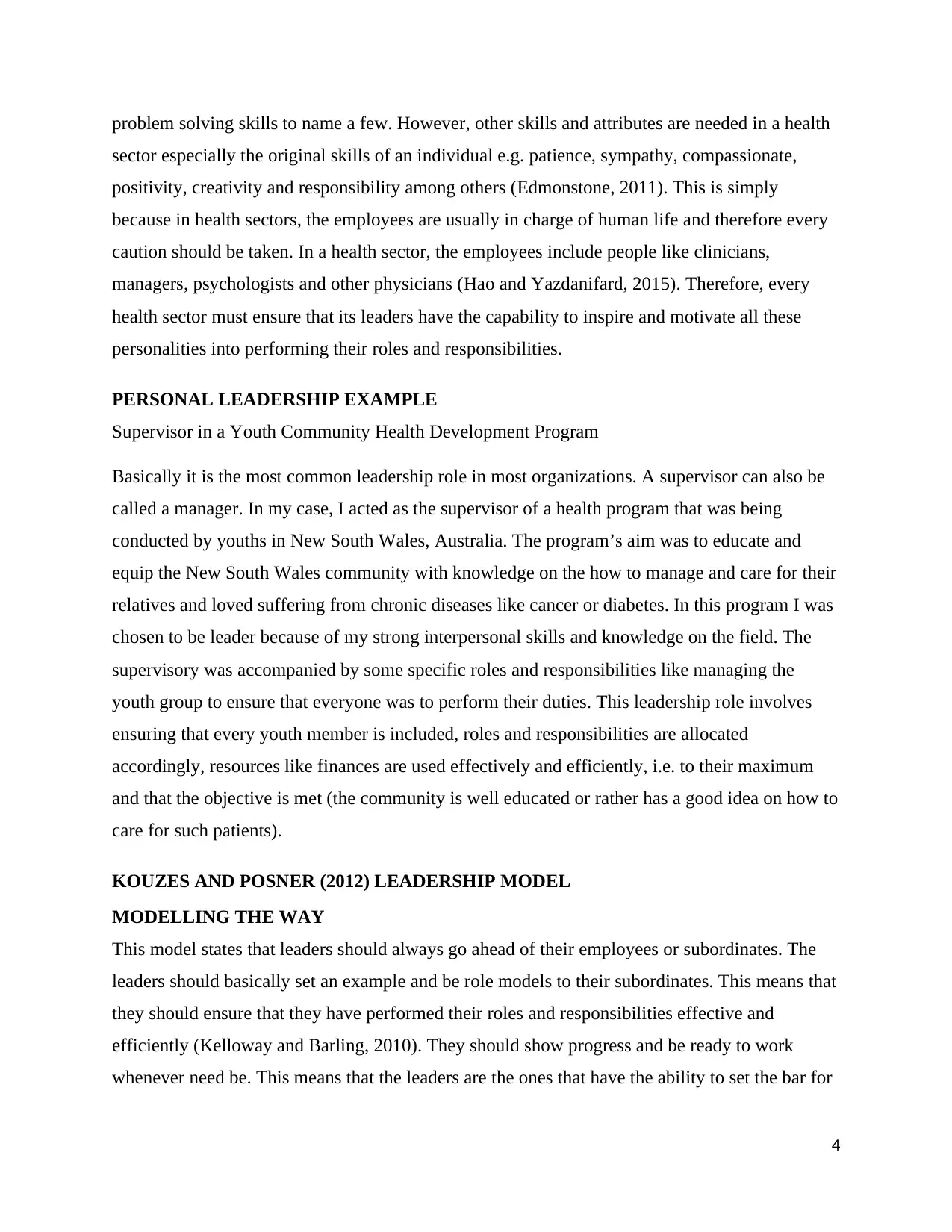
problem solving skills to name a few. However, other skills and attributes are needed in a health
sector especially the original skills of an individual e.g. patience, sympathy, compassionate,
positivity, creativity and responsibility among others (Edmonstone, 2011). This is simply
because in health sectors, the employees are usually in charge of human life and therefore every
caution should be taken. In a health sector, the employees include people like clinicians,
managers, psychologists and other physicians (Hao and Yazdanifard, 2015). Therefore, every
health sector must ensure that its leaders have the capability to inspire and motivate all these
personalities into performing their roles and responsibilities.
PERSONAL LEADERSHIP EXAMPLE
Supervisor in a Youth Community Health Development Program
Basically it is the most common leadership role in most organizations. A supervisor can also be
called a manager. In my case, I acted as the supervisor of a health program that was being
conducted by youths in New South Wales, Australia. The program’s aim was to educate and
equip the New South Wales community with knowledge on the how to manage and care for their
relatives and loved suffering from chronic diseases like cancer or diabetes. In this program I was
chosen to be leader because of my strong interpersonal skills and knowledge on the field. The
supervisory was accompanied by some specific roles and responsibilities like managing the
youth group to ensure that everyone was to perform their duties. This leadership role involves
ensuring that every youth member is included, roles and responsibilities are allocated
accordingly, resources like finances are used effectively and efficiently, i.e. to their maximum
and that the objective is met (the community is well educated or rather has a good idea on how to
care for such patients).
KOUZES AND POSNER (2012) LEADERSHIP MODEL
MODELLING THE WAY
This model states that leaders should always go ahead of their employees or subordinates. The
leaders should basically set an example and be role models to their subordinates. This means that
they should ensure that they have performed their roles and responsibilities effective and
efficiently (Kelloway and Barling, 2010). They should show progress and be ready to work
whenever need be. This means that the leaders are the ones that have the ability to set the bar for
4
sector especially the original skills of an individual e.g. patience, sympathy, compassionate,
positivity, creativity and responsibility among others (Edmonstone, 2011). This is simply
because in health sectors, the employees are usually in charge of human life and therefore every
caution should be taken. In a health sector, the employees include people like clinicians,
managers, psychologists and other physicians (Hao and Yazdanifard, 2015). Therefore, every
health sector must ensure that its leaders have the capability to inspire and motivate all these
personalities into performing their roles and responsibilities.
PERSONAL LEADERSHIP EXAMPLE
Supervisor in a Youth Community Health Development Program
Basically it is the most common leadership role in most organizations. A supervisor can also be
called a manager. In my case, I acted as the supervisor of a health program that was being
conducted by youths in New South Wales, Australia. The program’s aim was to educate and
equip the New South Wales community with knowledge on the how to manage and care for their
relatives and loved suffering from chronic diseases like cancer or diabetes. In this program I was
chosen to be leader because of my strong interpersonal skills and knowledge on the field. The
supervisory was accompanied by some specific roles and responsibilities like managing the
youth group to ensure that everyone was to perform their duties. This leadership role involves
ensuring that every youth member is included, roles and responsibilities are allocated
accordingly, resources like finances are used effectively and efficiently, i.e. to their maximum
and that the objective is met (the community is well educated or rather has a good idea on how to
care for such patients).
KOUZES AND POSNER (2012) LEADERSHIP MODEL
MODELLING THE WAY
This model states that leaders should always go ahead of their employees or subordinates. The
leaders should basically set an example and be role models to their subordinates. This means that
they should ensure that they have performed their roles and responsibilities effective and
efficiently (Kelloway and Barling, 2010). They should show progress and be ready to work
whenever need be. This means that the leaders are the ones that have the ability to set the bar for
4
Secure Best Marks with AI Grader
Need help grading? Try our AI Grader for instant feedback on your assignments.
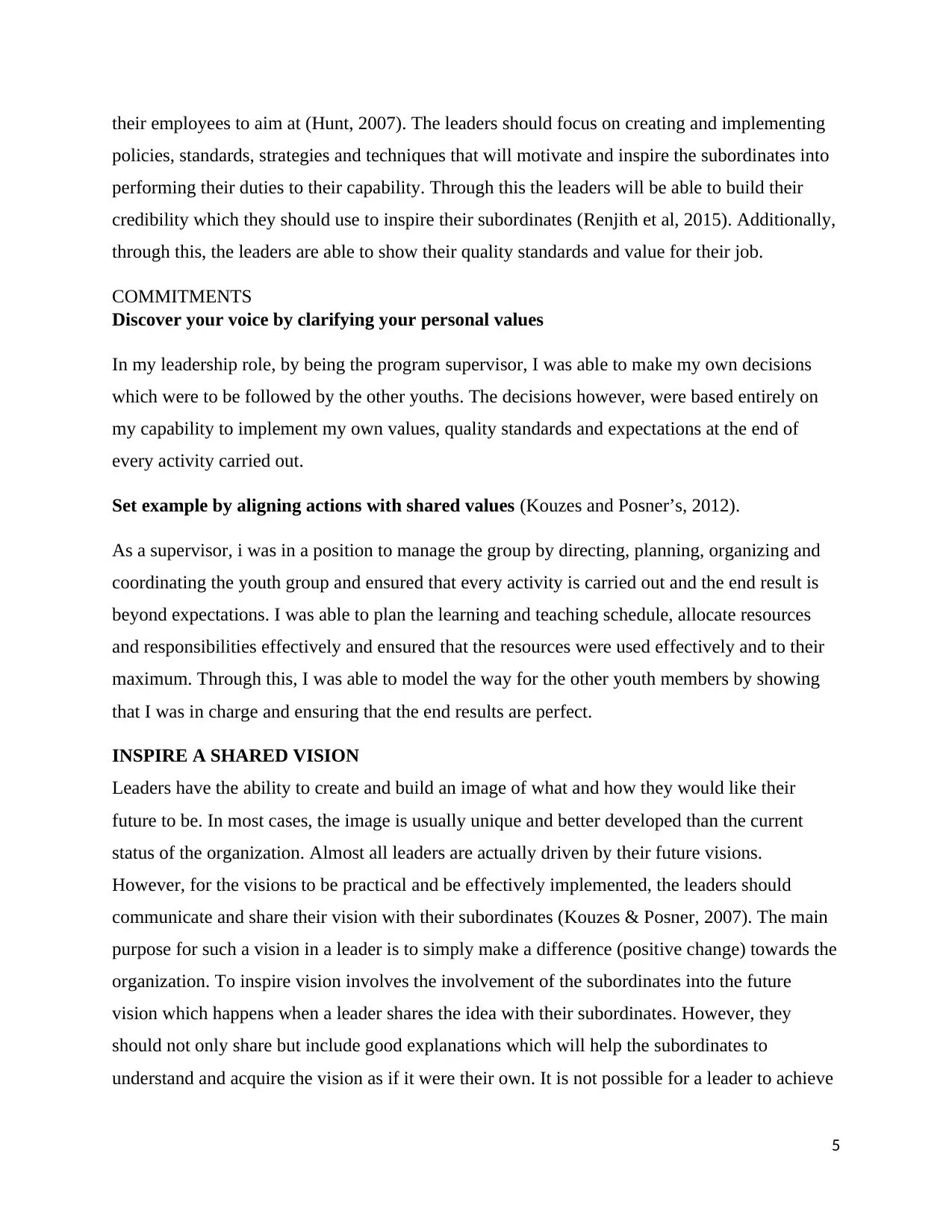
their employees to aim at (Hunt, 2007). The leaders should focus on creating and implementing
policies, standards, strategies and techniques that will motivate and inspire the subordinates into
performing their duties to their capability. Through this the leaders will be able to build their
credibility which they should use to inspire their subordinates (Renjith et al, 2015). Additionally,
through this, the leaders are able to show their quality standards and value for their job.
COMMITMENTS
Discover your voice by clarifying your personal values
In my leadership role, by being the program supervisor, I was able to make my own decisions
which were to be followed by the other youths. The decisions however, were based entirely on
my capability to implement my own values, quality standards and expectations at the end of
every activity carried out.
Set example by aligning actions with shared values (Kouzes and Posner’s, 2012).
As a supervisor, i was in a position to manage the group by directing, planning, organizing and
coordinating the youth group and ensured that every activity is carried out and the end result is
beyond expectations. I was able to plan the learning and teaching schedule, allocate resources
and responsibilities effectively and ensured that the resources were used effectively and to their
maximum. Through this, I was able to model the way for the other youth members by showing
that I was in charge and ensuring that the end results are perfect.
INSPIRE A SHARED VISION
Leaders have the ability to create and build an image of what and how they would like their
future to be. In most cases, the image is usually unique and better developed than the current
status of the organization. Almost all leaders are actually driven by their future visions.
However, for the visions to be practical and be effectively implemented, the leaders should
communicate and share their vision with their subordinates (Kouzes & Posner, 2007). The main
purpose for such a vision in a leader is to simply make a difference (positive change) towards the
organization. To inspire vision involves the involvement of the subordinates into the future
vision which happens when a leader shares the idea with their subordinates. However, they
should not only share but include good explanations which will help the subordinates to
understand and acquire the vision as if it were their own. It is not possible for a leader to achieve
5
policies, standards, strategies and techniques that will motivate and inspire the subordinates into
performing their duties to their capability. Through this the leaders will be able to build their
credibility which they should use to inspire their subordinates (Renjith et al, 2015). Additionally,
through this, the leaders are able to show their quality standards and value for their job.
COMMITMENTS
Discover your voice by clarifying your personal values
In my leadership role, by being the program supervisor, I was able to make my own decisions
which were to be followed by the other youths. The decisions however, were based entirely on
my capability to implement my own values, quality standards and expectations at the end of
every activity carried out.
Set example by aligning actions with shared values (Kouzes and Posner’s, 2012).
As a supervisor, i was in a position to manage the group by directing, planning, organizing and
coordinating the youth group and ensured that every activity is carried out and the end result is
beyond expectations. I was able to plan the learning and teaching schedule, allocate resources
and responsibilities effectively and ensured that the resources were used effectively and to their
maximum. Through this, I was able to model the way for the other youth members by showing
that I was in charge and ensuring that the end results are perfect.
INSPIRE A SHARED VISION
Leaders have the ability to create and build an image of what and how they would like their
future to be. In most cases, the image is usually unique and better developed than the current
status of the organization. Almost all leaders are actually driven by their future visions.
However, for the visions to be practical and be effectively implemented, the leaders should
communicate and share their vision with their subordinates (Kouzes & Posner, 2007). The main
purpose for such a vision in a leader is to simply make a difference (positive change) towards the
organization. To inspire vision involves the involvement of the subordinates into the future
vision which happens when a leader shares the idea with their subordinates. However, they
should not only share but include good explanations which will help the subordinates to
understand and acquire the vision as if it were their own. It is not possible for a leader to achieve
5
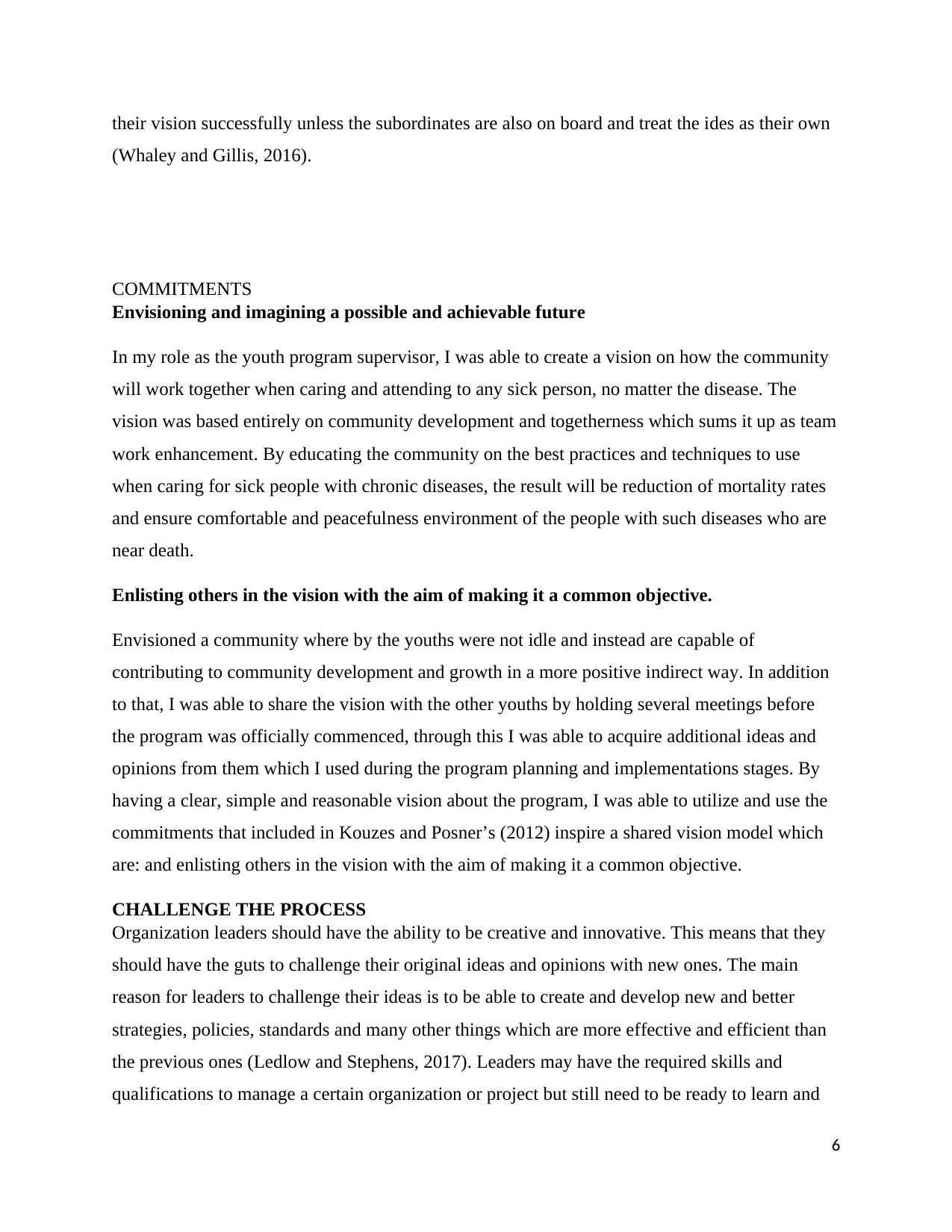
their vision successfully unless the subordinates are also on board and treat the ides as their own
(Whaley and Gillis, 2016).
COMMITMENTS
Envisioning and imagining a possible and achievable future
In my role as the youth program supervisor, I was able to create a vision on how the community
will work together when caring and attending to any sick person, no matter the disease. The
vision was based entirely on community development and togetherness which sums it up as team
work enhancement. By educating the community on the best practices and techniques to use
when caring for sick people with chronic diseases, the result will be reduction of mortality rates
and ensure comfortable and peacefulness environment of the people with such diseases who are
near death.
Enlisting others in the vision with the aim of making it a common objective.
Envisioned a community where by the youths were not idle and instead are capable of
contributing to community development and growth in a more positive indirect way. In addition
to that, I was able to share the vision with the other youths by holding several meetings before
the program was officially commenced, through this I was able to acquire additional ideas and
opinions from them which I used during the program planning and implementations stages. By
having a clear, simple and reasonable vision about the program, I was able to utilize and use the
commitments that included in Kouzes and Posner’s (2012) inspire a shared vision model which
are: and enlisting others in the vision with the aim of making it a common objective.
CHALLENGE THE PROCESS
Organization leaders should have the ability to be creative and innovative. This means that they
should have the guts to challenge their original ideas and opinions with new ones. The main
reason for leaders to challenge their ideas is to be able to create and develop new and better
strategies, policies, standards and many other things which are more effective and efficient than
the previous ones (Ledlow and Stephens, 2017). Leaders may have the required skills and
qualifications to manage a certain organization or project but still need to be ready to learn and
6
(Whaley and Gillis, 2016).
COMMITMENTS
Envisioning and imagining a possible and achievable future
In my role as the youth program supervisor, I was able to create a vision on how the community
will work together when caring and attending to any sick person, no matter the disease. The
vision was based entirely on community development and togetherness which sums it up as team
work enhancement. By educating the community on the best practices and techniques to use
when caring for sick people with chronic diseases, the result will be reduction of mortality rates
and ensure comfortable and peacefulness environment of the people with such diseases who are
near death.
Enlisting others in the vision with the aim of making it a common objective.
Envisioned a community where by the youths were not idle and instead are capable of
contributing to community development and growth in a more positive indirect way. In addition
to that, I was able to share the vision with the other youths by holding several meetings before
the program was officially commenced, through this I was able to acquire additional ideas and
opinions from them which I used during the program planning and implementations stages. By
having a clear, simple and reasonable vision about the program, I was able to utilize and use the
commitments that included in Kouzes and Posner’s (2012) inspire a shared vision model which
are: and enlisting others in the vision with the aim of making it a common objective.
CHALLENGE THE PROCESS
Organization leaders should have the ability to be creative and innovative. This means that they
should have the guts to challenge their original ideas and opinions with new ones. The main
reason for leaders to challenge their ideas is to be able to create and develop new and better
strategies, policies, standards and many other things which are more effective and efficient than
the previous ones (Ledlow and Stephens, 2017). Leaders may have the required skills and
qualifications to manage a certain organization or project but still need to be ready to learn and
6
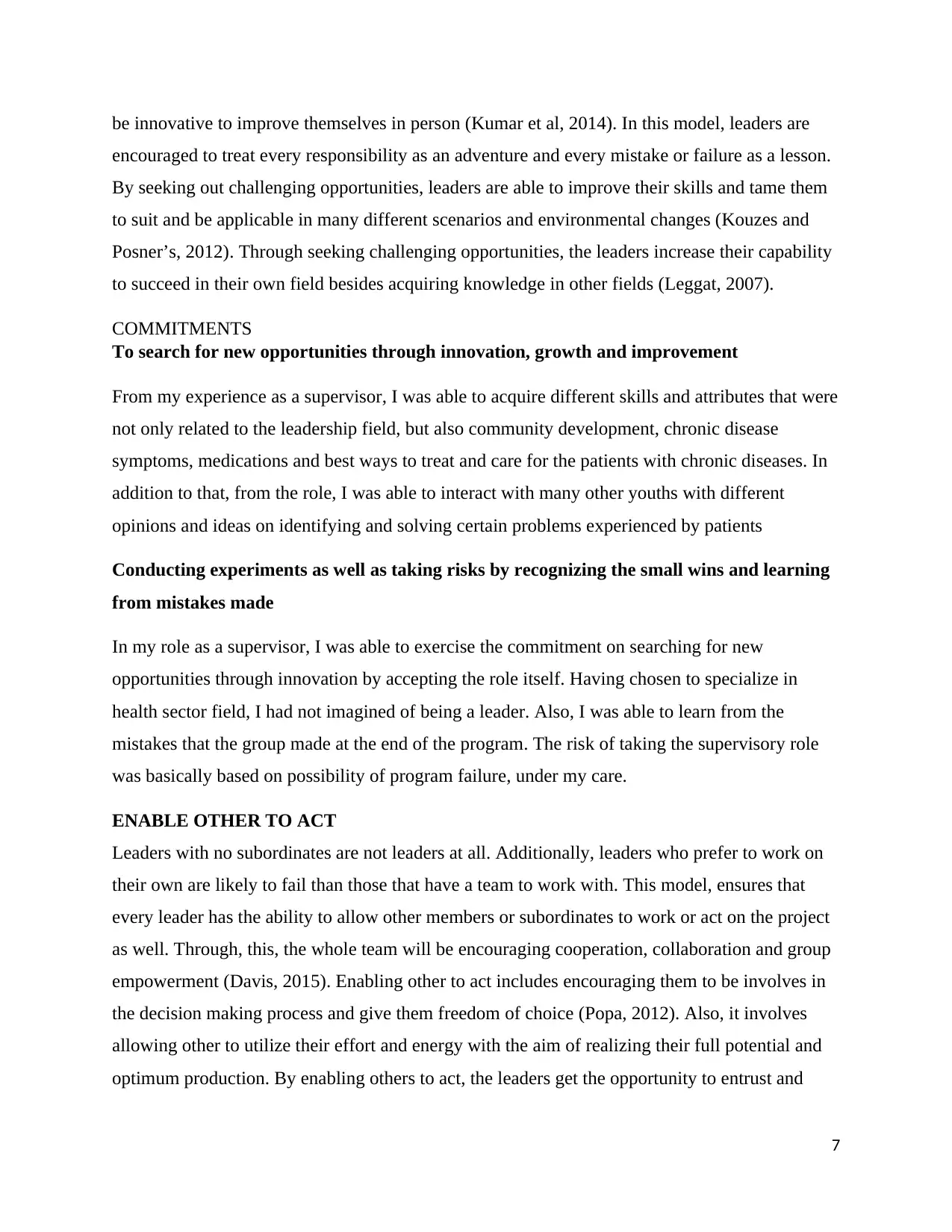
be innovative to improve themselves in person (Kumar et al, 2014). In this model, leaders are
encouraged to treat every responsibility as an adventure and every mistake or failure as a lesson.
By seeking out challenging opportunities, leaders are able to improve their skills and tame them
to suit and be applicable in many different scenarios and environmental changes (Kouzes and
Posner’s, 2012). Through seeking challenging opportunities, the leaders increase their capability
to succeed in their own field besides acquiring knowledge in other fields (Leggat, 2007).
COMMITMENTS
To search for new opportunities through innovation, growth and improvement
From my experience as a supervisor, I was able to acquire different skills and attributes that were
not only related to the leadership field, but also community development, chronic disease
symptoms, medications and best ways to treat and care for the patients with chronic diseases. In
addition to that, from the role, I was able to interact with many other youths with different
opinions and ideas on identifying and solving certain problems experienced by patients
Conducting experiments as well as taking risks by recognizing the small wins and learning
from mistakes made
In my role as a supervisor, I was able to exercise the commitment on searching for new
opportunities through innovation by accepting the role itself. Having chosen to specialize in
health sector field, I had not imagined of being a leader. Also, I was able to learn from the
mistakes that the group made at the end of the program. The risk of taking the supervisory role
was basically based on possibility of program failure, under my care.
ENABLE OTHER TO ACT
Leaders with no subordinates are not leaders at all. Additionally, leaders who prefer to work on
their own are likely to fail than those that have a team to work with. This model, ensures that
every leader has the ability to allow other members or subordinates to work or act on the project
as well. Through, this, the whole team will be encouraging cooperation, collaboration and group
empowerment (Davis, 2015). Enabling other to act includes encouraging them to be involves in
the decision making process and give them freedom of choice (Popa, 2012). Also, it involves
allowing other to utilize their effort and energy with the aim of realizing their full potential and
optimum production. By enabling others to act, the leaders get the opportunity to entrust and
7
encouraged to treat every responsibility as an adventure and every mistake or failure as a lesson.
By seeking out challenging opportunities, leaders are able to improve their skills and tame them
to suit and be applicable in many different scenarios and environmental changes (Kouzes and
Posner’s, 2012). Through seeking challenging opportunities, the leaders increase their capability
to succeed in their own field besides acquiring knowledge in other fields (Leggat, 2007).
COMMITMENTS
To search for new opportunities through innovation, growth and improvement
From my experience as a supervisor, I was able to acquire different skills and attributes that were
not only related to the leadership field, but also community development, chronic disease
symptoms, medications and best ways to treat and care for the patients with chronic diseases. In
addition to that, from the role, I was able to interact with many other youths with different
opinions and ideas on identifying and solving certain problems experienced by patients
Conducting experiments as well as taking risks by recognizing the small wins and learning
from mistakes made
In my role as a supervisor, I was able to exercise the commitment on searching for new
opportunities through innovation by accepting the role itself. Having chosen to specialize in
health sector field, I had not imagined of being a leader. Also, I was able to learn from the
mistakes that the group made at the end of the program. The risk of taking the supervisory role
was basically based on possibility of program failure, under my care.
ENABLE OTHER TO ACT
Leaders with no subordinates are not leaders at all. Additionally, leaders who prefer to work on
their own are likely to fail than those that have a team to work with. This model, ensures that
every leader has the ability to allow other members or subordinates to work or act on the project
as well. Through, this, the whole team will be encouraging cooperation, collaboration and group
empowerment (Davis, 2015). Enabling other to act includes encouraging them to be involves in
the decision making process and give them freedom of choice (Popa, 2012). Also, it involves
allowing other to utilize their effort and energy with the aim of realizing their full potential and
optimum production. By enabling others to act, the leaders get the opportunity to entrust and
7
Paraphrase This Document
Need a fresh take? Get an instant paraphrase of this document with our AI Paraphraser
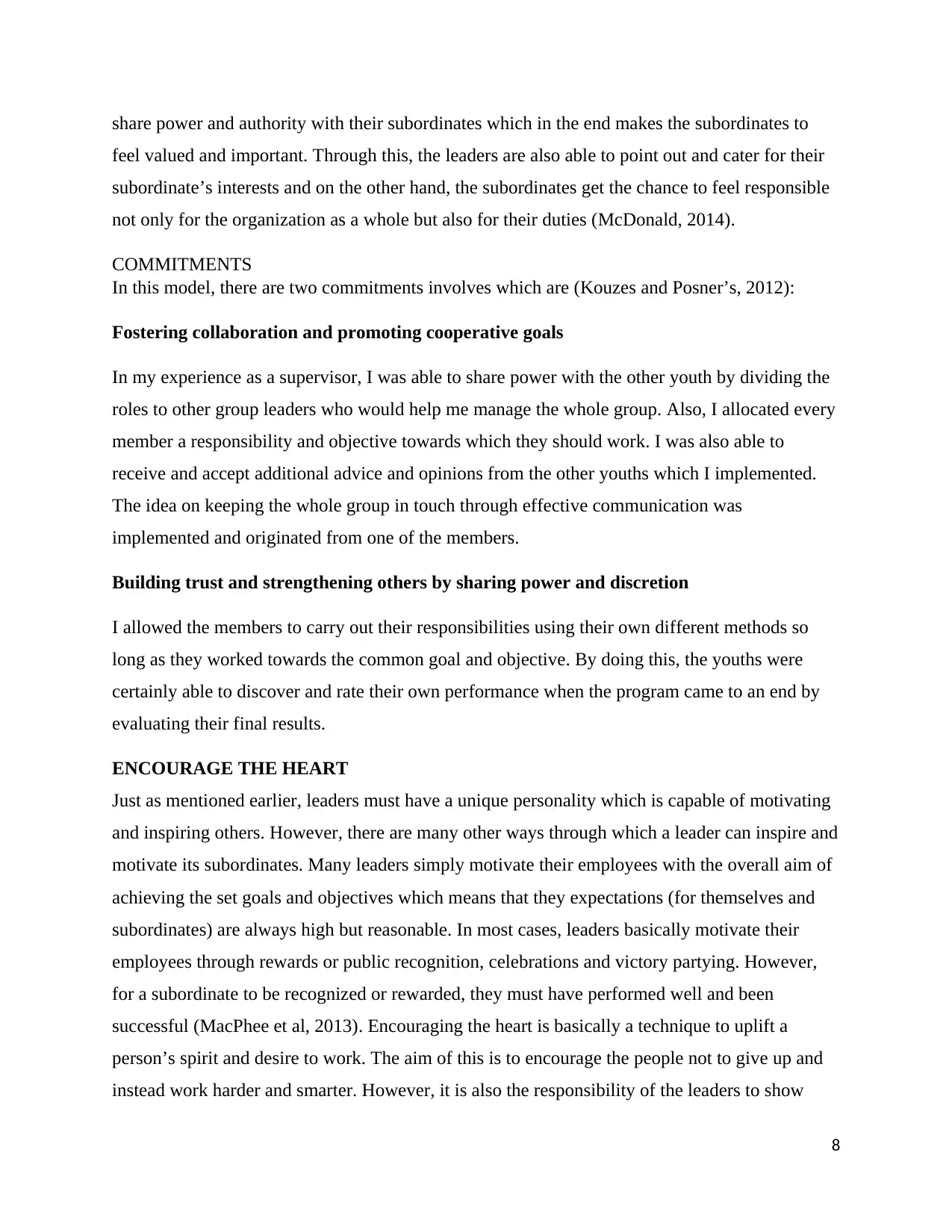
share power and authority with their subordinates which in the end makes the subordinates to
feel valued and important. Through this, the leaders are also able to point out and cater for their
subordinate’s interests and on the other hand, the subordinates get the chance to feel responsible
not only for the organization as a whole but also for their duties (McDonald, 2014).
COMMITMENTS
In this model, there are two commitments involves which are (Kouzes and Posner’s, 2012):
Fostering collaboration and promoting cooperative goals
In my experience as a supervisor, I was able to share power with the other youth by dividing the
roles to other group leaders who would help me manage the whole group. Also, I allocated every
member a responsibility and objective towards which they should work. I was also able to
receive and accept additional advice and opinions from the other youths which I implemented.
The idea on keeping the whole group in touch through effective communication was
implemented and originated from one of the members.
Building trust and strengthening others by sharing power and discretion
I allowed the members to carry out their responsibilities using their own different methods so
long as they worked towards the common goal and objective. By doing this, the youths were
certainly able to discover and rate their own performance when the program came to an end by
evaluating their final results.
ENCOURAGE THE HEART
Just as mentioned earlier, leaders must have a unique personality which is capable of motivating
and inspiring others. However, there are many other ways through which a leader can inspire and
motivate its subordinates. Many leaders simply motivate their employees with the overall aim of
achieving the set goals and objectives which means that they expectations (for themselves and
subordinates) are always high but reasonable. In most cases, leaders basically motivate their
employees through rewards or public recognition, celebrations and victory partying. However,
for a subordinate to be recognized or rewarded, they must have performed well and been
successful (MacPhee et al, 2013). Encouraging the heart is basically a technique to uplift a
person’s spirit and desire to work. The aim of this is to encourage the people not to give up and
instead work harder and smarter. However, it is also the responsibility of the leaders to show
8
feel valued and important. Through this, the leaders are also able to point out and cater for their
subordinate’s interests and on the other hand, the subordinates get the chance to feel responsible
not only for the organization as a whole but also for their duties (McDonald, 2014).
COMMITMENTS
In this model, there are two commitments involves which are (Kouzes and Posner’s, 2012):
Fostering collaboration and promoting cooperative goals
In my experience as a supervisor, I was able to share power with the other youth by dividing the
roles to other group leaders who would help me manage the whole group. Also, I allocated every
member a responsibility and objective towards which they should work. I was also able to
receive and accept additional advice and opinions from the other youths which I implemented.
The idea on keeping the whole group in touch through effective communication was
implemented and originated from one of the members.
Building trust and strengthening others by sharing power and discretion
I allowed the members to carry out their responsibilities using their own different methods so
long as they worked towards the common goal and objective. By doing this, the youths were
certainly able to discover and rate their own performance when the program came to an end by
evaluating their final results.
ENCOURAGE THE HEART
Just as mentioned earlier, leaders must have a unique personality which is capable of motivating
and inspiring others. However, there are many other ways through which a leader can inspire and
motivate its subordinates. Many leaders simply motivate their employees with the overall aim of
achieving the set goals and objectives which means that they expectations (for themselves and
subordinates) are always high but reasonable. In most cases, leaders basically motivate their
employees through rewards or public recognition, celebrations and victory partying. However,
for a subordinate to be recognized or rewarded, they must have performed well and been
successful (MacPhee et al, 2013). Encouraging the heart is basically a technique to uplift a
person’s spirit and desire to work. The aim of this is to encourage the people not to give up and
instead work harder and smarter. However, it is also the responsibility of the leaders to show
8
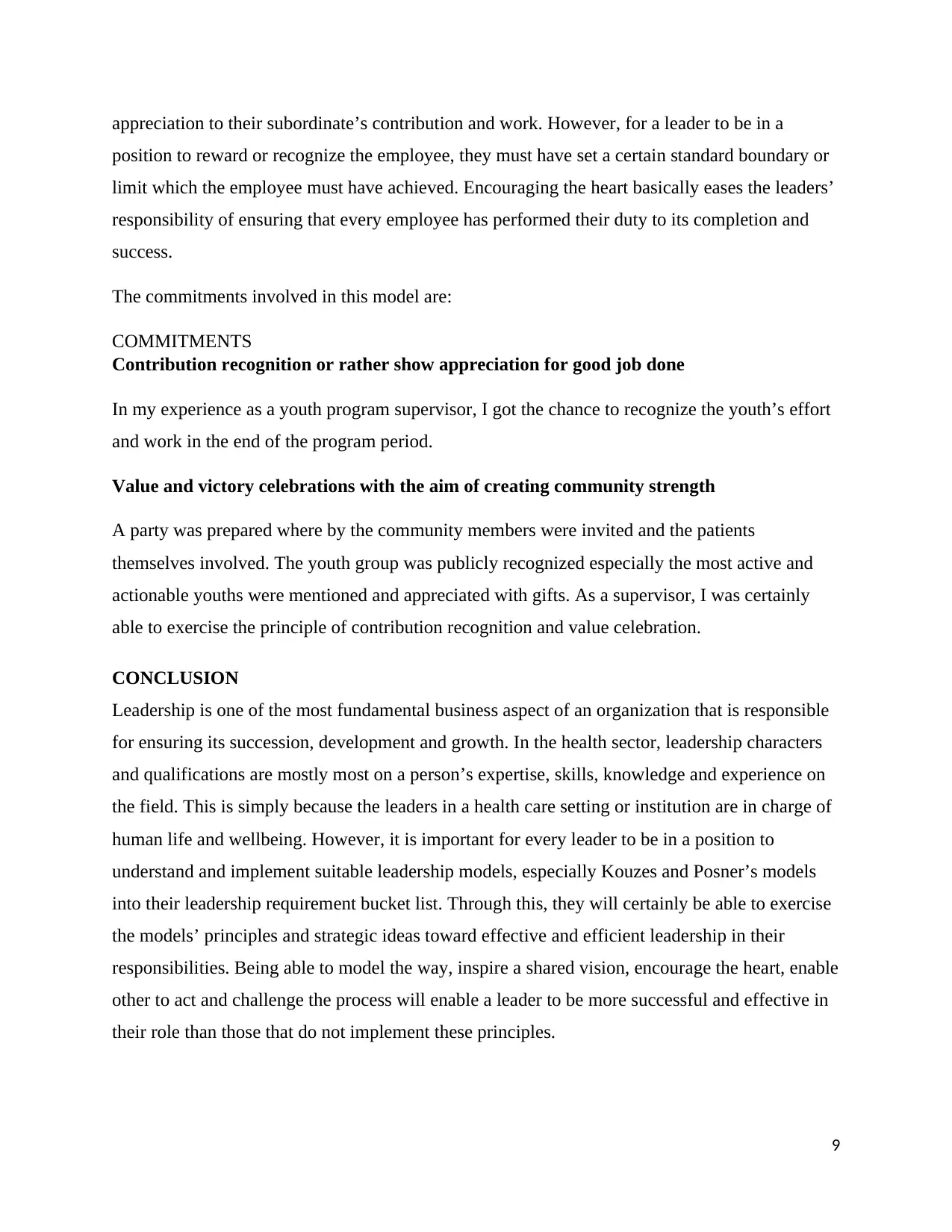
appreciation to their subordinate’s contribution and work. However, for a leader to be in a
position to reward or recognize the employee, they must have set a certain standard boundary or
limit which the employee must have achieved. Encouraging the heart basically eases the leaders’
responsibility of ensuring that every employee has performed their duty to its completion and
success.
The commitments involved in this model are:
COMMITMENTS
Contribution recognition or rather show appreciation for good job done
In my experience as a youth program supervisor, I got the chance to recognize the youth’s effort
and work in the end of the program period.
Value and victory celebrations with the aim of creating community strength
A party was prepared where by the community members were invited and the patients
themselves involved. The youth group was publicly recognized especially the most active and
actionable youths were mentioned and appreciated with gifts. As a supervisor, I was certainly
able to exercise the principle of contribution recognition and value celebration.
CONCLUSION
Leadership is one of the most fundamental business aspect of an organization that is responsible
for ensuring its succession, development and growth. In the health sector, leadership characters
and qualifications are mostly most on a person’s expertise, skills, knowledge and experience on
the field. This is simply because the leaders in a health care setting or institution are in charge of
human life and wellbeing. However, it is important for every leader to be in a position to
understand and implement suitable leadership models, especially Kouzes and Posner’s models
into their leadership requirement bucket list. Through this, they will certainly be able to exercise
the models’ principles and strategic ideas toward effective and efficient leadership in their
responsibilities. Being able to model the way, inspire a shared vision, encourage the heart, enable
other to act and challenge the process will enable a leader to be more successful and effective in
their role than those that do not implement these principles.
9
position to reward or recognize the employee, they must have set a certain standard boundary or
limit which the employee must have achieved. Encouraging the heart basically eases the leaders’
responsibility of ensuring that every employee has performed their duty to its completion and
success.
The commitments involved in this model are:
COMMITMENTS
Contribution recognition or rather show appreciation for good job done
In my experience as a youth program supervisor, I got the chance to recognize the youth’s effort
and work in the end of the program period.
Value and victory celebrations with the aim of creating community strength
A party was prepared where by the community members were invited and the patients
themselves involved. The youth group was publicly recognized especially the most active and
actionable youths were mentioned and appreciated with gifts. As a supervisor, I was certainly
able to exercise the principle of contribution recognition and value celebration.
CONCLUSION
Leadership is one of the most fundamental business aspect of an organization that is responsible
for ensuring its succession, development and growth. In the health sector, leadership characters
and qualifications are mostly most on a person’s expertise, skills, knowledge and experience on
the field. This is simply because the leaders in a health care setting or institution are in charge of
human life and wellbeing. However, it is important for every leader to be in a position to
understand and implement suitable leadership models, especially Kouzes and Posner’s models
into their leadership requirement bucket list. Through this, they will certainly be able to exercise
the models’ principles and strategic ideas toward effective and efficient leadership in their
responsibilities. Being able to model the way, inspire a shared vision, encourage the heart, enable
other to act and challenge the process will enable a leader to be more successful and effective in
their role than those that do not implement these principles.
9
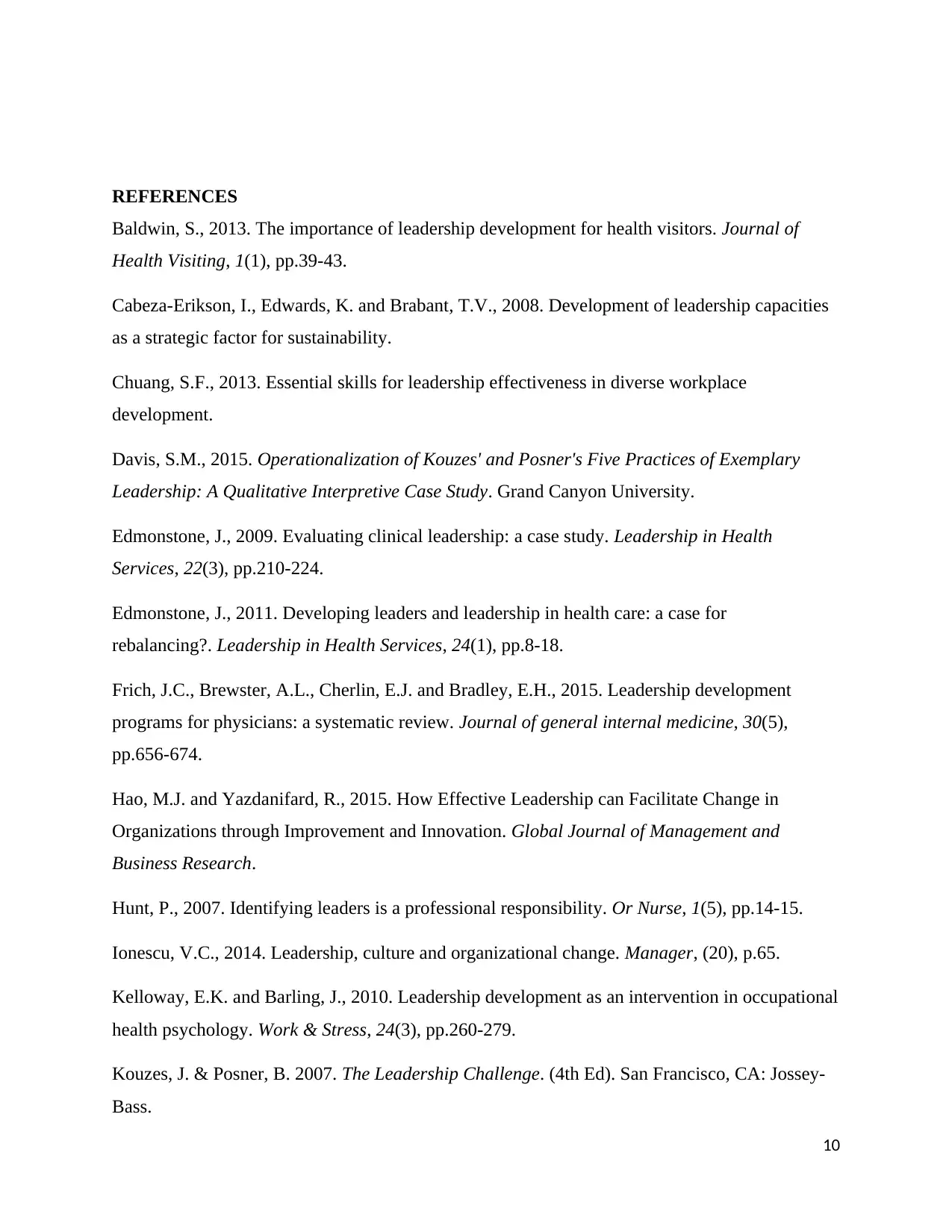
REFERENCES
Baldwin, S., 2013. The importance of leadership development for health visitors. Journal of
Health Visiting, 1(1), pp.39-43.
Cabeza-Erikson, I., Edwards, K. and Brabant, T.V., 2008. Development of leadership capacities
as a strategic factor for sustainability.
Chuang, S.F., 2013. Essential skills for leadership effectiveness in diverse workplace
development.
Davis, S.M., 2015. Operationalization of Kouzes' and Posner's Five Practices of Exemplary
Leadership: A Qualitative Interpretive Case Study. Grand Canyon University.
Edmonstone, J., 2009. Evaluating clinical leadership: a case study. Leadership in Health
Services, 22(3), pp.210-224.
Edmonstone, J., 2011. Developing leaders and leadership in health care: a case for
rebalancing?. Leadership in Health Services, 24(1), pp.8-18.
Frich, J.C., Brewster, A.L., Cherlin, E.J. and Bradley, E.H., 2015. Leadership development
programs for physicians: a systematic review. Journal of general internal medicine, 30(5),
pp.656-674.
Hao, M.J. and Yazdanifard, R., 2015. How Effective Leadership can Facilitate Change in
Organizations through Improvement and Innovation. Global Journal of Management and
Business Research.
Hunt, P., 2007. Identifying leaders is a professional responsibility. Or Nurse, 1(5), pp.14-15.
Ionescu, V.C., 2014. Leadership, culture and organizational change. Manager, (20), p.65.
Kelloway, E.K. and Barling, J., 2010. Leadership development as an intervention in occupational
health psychology. Work & Stress, 24(3), pp.260-279.
Kouzes, J. & Posner, B. 2007. The Leadership Challenge. (4th Ed). San Francisco, CA: Jossey-
Bass.
10
Baldwin, S., 2013. The importance of leadership development for health visitors. Journal of
Health Visiting, 1(1), pp.39-43.
Cabeza-Erikson, I., Edwards, K. and Brabant, T.V., 2008. Development of leadership capacities
as a strategic factor for sustainability.
Chuang, S.F., 2013. Essential skills for leadership effectiveness in diverse workplace
development.
Davis, S.M., 2015. Operationalization of Kouzes' and Posner's Five Practices of Exemplary
Leadership: A Qualitative Interpretive Case Study. Grand Canyon University.
Edmonstone, J., 2009. Evaluating clinical leadership: a case study. Leadership in Health
Services, 22(3), pp.210-224.
Edmonstone, J., 2011. Developing leaders and leadership in health care: a case for
rebalancing?. Leadership in Health Services, 24(1), pp.8-18.
Frich, J.C., Brewster, A.L., Cherlin, E.J. and Bradley, E.H., 2015. Leadership development
programs for physicians: a systematic review. Journal of general internal medicine, 30(5),
pp.656-674.
Hao, M.J. and Yazdanifard, R., 2015. How Effective Leadership can Facilitate Change in
Organizations through Improvement and Innovation. Global Journal of Management and
Business Research.
Hunt, P., 2007. Identifying leaders is a professional responsibility. Or Nurse, 1(5), pp.14-15.
Ionescu, V.C., 2014. Leadership, culture and organizational change. Manager, (20), p.65.
Kelloway, E.K. and Barling, J., 2010. Leadership development as an intervention in occupational
health psychology. Work & Stress, 24(3), pp.260-279.
Kouzes, J. & Posner, B. 2007. The Leadership Challenge. (4th Ed). San Francisco, CA: Jossey-
Bass.
10
Secure Best Marks with AI Grader
Need help grading? Try our AI Grader for instant feedback on your assignments.
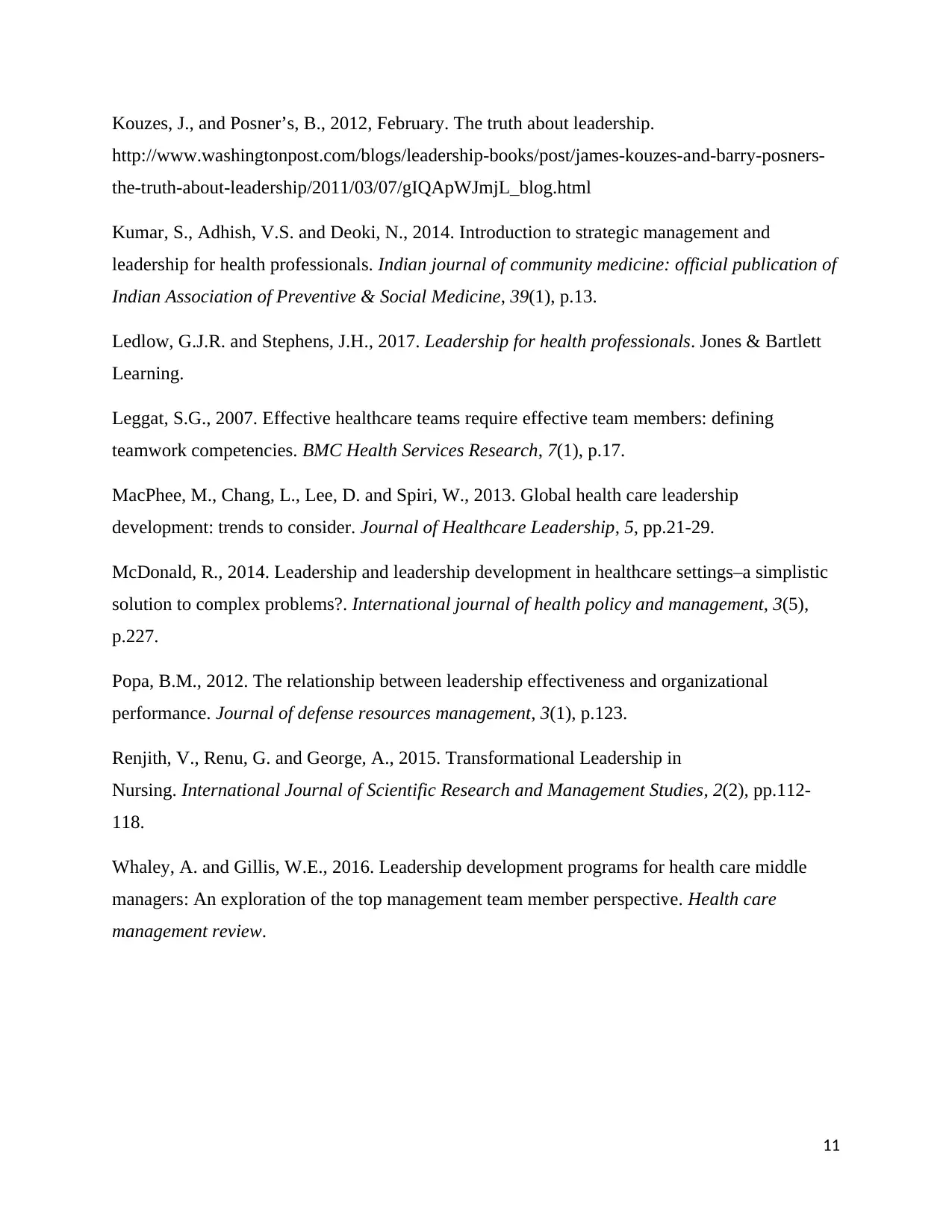
Kouzes, J., and Posner’s, B., 2012, February. The truth about leadership.
http://www.washingtonpost.com/blogs/leadership-books/post/james-kouzes-and-barry-posners-
the-truth-about-leadership/2011/03/07/gIQApWJmjL_blog.html
Kumar, S., Adhish, V.S. and Deoki, N., 2014. Introduction to strategic management and
leadership for health professionals. Indian journal of community medicine: official publication of
Indian Association of Preventive & Social Medicine, 39(1), p.13.
Ledlow, G.J.R. and Stephens, J.H., 2017. Leadership for health professionals. Jones & Bartlett
Learning.
Leggat, S.G., 2007. Effective healthcare teams require effective team members: defining
teamwork competencies. BMC Health Services Research, 7(1), p.17.
MacPhee, M., Chang, L., Lee, D. and Spiri, W., 2013. Global health care leadership
development: trends to consider. Journal of Healthcare Leadership, 5, pp.21-29.
McDonald, R., 2014. Leadership and leadership development in healthcare settings–a simplistic
solution to complex problems?. International journal of health policy and management, 3(5),
p.227.
Popa, B.M., 2012. The relationship between leadership effectiveness and organizational
performance. Journal of defense resources management, 3(1), p.123.
Renjith, V., Renu, G. and George, A., 2015. Transformational Leadership in
Nursing. International Journal of Scientific Research and Management Studies, 2(2), pp.112-
118.
Whaley, A. and Gillis, W.E., 2016. Leadership development programs for health care middle
managers: An exploration of the top management team member perspective. Health care
management review.
11
http://www.washingtonpost.com/blogs/leadership-books/post/james-kouzes-and-barry-posners-
the-truth-about-leadership/2011/03/07/gIQApWJmjL_blog.html
Kumar, S., Adhish, V.S. and Deoki, N., 2014. Introduction to strategic management and
leadership for health professionals. Indian journal of community medicine: official publication of
Indian Association of Preventive & Social Medicine, 39(1), p.13.
Ledlow, G.J.R. and Stephens, J.H., 2017. Leadership for health professionals. Jones & Bartlett
Learning.
Leggat, S.G., 2007. Effective healthcare teams require effective team members: defining
teamwork competencies. BMC Health Services Research, 7(1), p.17.
MacPhee, M., Chang, L., Lee, D. and Spiri, W., 2013. Global health care leadership
development: trends to consider. Journal of Healthcare Leadership, 5, pp.21-29.
McDonald, R., 2014. Leadership and leadership development in healthcare settings–a simplistic
solution to complex problems?. International journal of health policy and management, 3(5),
p.227.
Popa, B.M., 2012. The relationship between leadership effectiveness and organizational
performance. Journal of defense resources management, 3(1), p.123.
Renjith, V., Renu, G. and George, A., 2015. Transformational Leadership in
Nursing. International Journal of Scientific Research and Management Studies, 2(2), pp.112-
118.
Whaley, A. and Gillis, W.E., 2016. Leadership development programs for health care middle
managers: An exploration of the top management team member perspective. Health care
management review.
11
1 out of 11
Related Documents
Your All-in-One AI-Powered Toolkit for Academic Success.
+13062052269
info@desklib.com
Available 24*7 on WhatsApp / Email
![[object Object]](/_next/static/media/star-bottom.7253800d.svg)
Unlock your academic potential
© 2024 | Zucol Services PVT LTD | All rights reserved.




